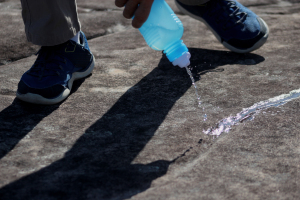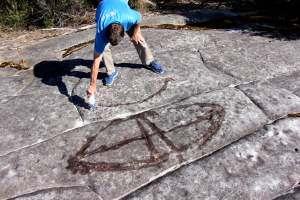
Engraved in soft Hawkesbury sandstone thousands of years ago, ancient Aboriginal rock engravings found in Ku-ring-gai Chase National Park are so precious, so culturally significant and so at risk that Sydney OutBack believes it rightly deserves its National Heritage listing awarded in 2006.
Australia’s second oldest National Park, Ku-ring-gai Chase, is home to the world’s most concentrated collection of more than 1,500 recorded Aboriginal heritage sites, which are surprisingly close to the CBD, within Greater Sydney. These incredible yet vulnerable engravings are a historical and cultural time capsule, pecked into comparatively soft Hawkesbury sandstone typical of the Sydney region.
The sandstone’s workability attracted a proliferation of engravings across the region over ten thousands of years before colonisation in 1788, which were maintained diligently through numerous ceremonies and by incorporation into everyday life of the Guringai Aboriginal people. The lines were created by chiseling an outline of holes that are manually “drilled” using a pointed stone or shell. These are subsequently joined into a line by rubbing a sharp stone along the punctured grove to a depth around 20mm deep in a characteristic U-shape.
Tragically, the decimation and evacuation of the Guringai population in the first decade of colonization* abandoned the engravings (and other heritage sites) to the elements. Engravings recorded at more than 25cm deep in 1870, today measure at less than 5cm, for reasons such as:


Preserved largely by its out-of-the-way location, the ancient “simple figurative” engravings in Ku-ring-gai Chase represent generations of knowledge handed down from Guringai ancestors to communicate teachings, cultural traditions and spiritual beliefs. For example, the Emu in the Sky engraving has significant spiritual meaning to the Aboriginal people, while also aligning with astronomical formations in the Milky Way each April/May (Australian autumn) to practically indicate the seasonal time to gather emu eggs (Learn about Emus at our blog, here).
Many engravings in Ku-ring-gai Chase include depictions of animals, fish and reptiles, like emus and wallabies, goannas and even a whale, and depict species that are now extinct or no longer in the region, or were not known to inhabit the region at the time of European documentation Engravings also include territorial shield markers, and sacred Dreaming images of the Aboriginal creator-hero Daramulum and his Emu wife, and the creation Rainbow Serpent to facilitate the handing-down of creation Dreamtime stories. These engravings are known by and significant to Aboriginal communities all around Australia. To be maintained, they need re-grooving by skilled Aboriginal elders for whom the engravings hold meaningful significance and who have the knowledge and authority – or they will be forever lost. This race against time and the elements is all the more reason to preserve their legacy at the highest level.
Here, in Ku-ring-gai Chase National Park, Sydney OutBack – an EcoPass certified company – has permission from local Aboriginal elders to visit this precious site to help non-Aboriginal people appreciate the richness of the world’s oldest living culture’s spiritual, relational, ceremonial, astronomical, seasonal and historical wisdom. To learn more about Sydney OutBack’s Wilderness and Aboriginal Explorer Tour and Cruise, just click here.
Our tours are also part of Tourism Australia’s Indigenous Tourism Champions Program (ITCP), recognizing that we offer a quality experience that that meets the needs and expectations of international visitors.
Excellent summary article explaining why Australia’s Aboriginal rock art is at risk of loss here. Read about Colonial Exploration, and its impact on the Aboriginal people living in the region, here on our blog.